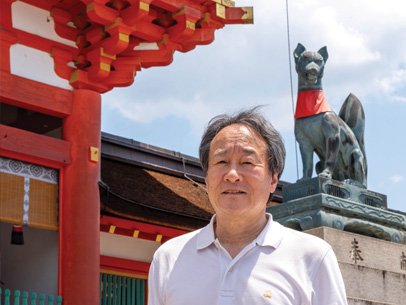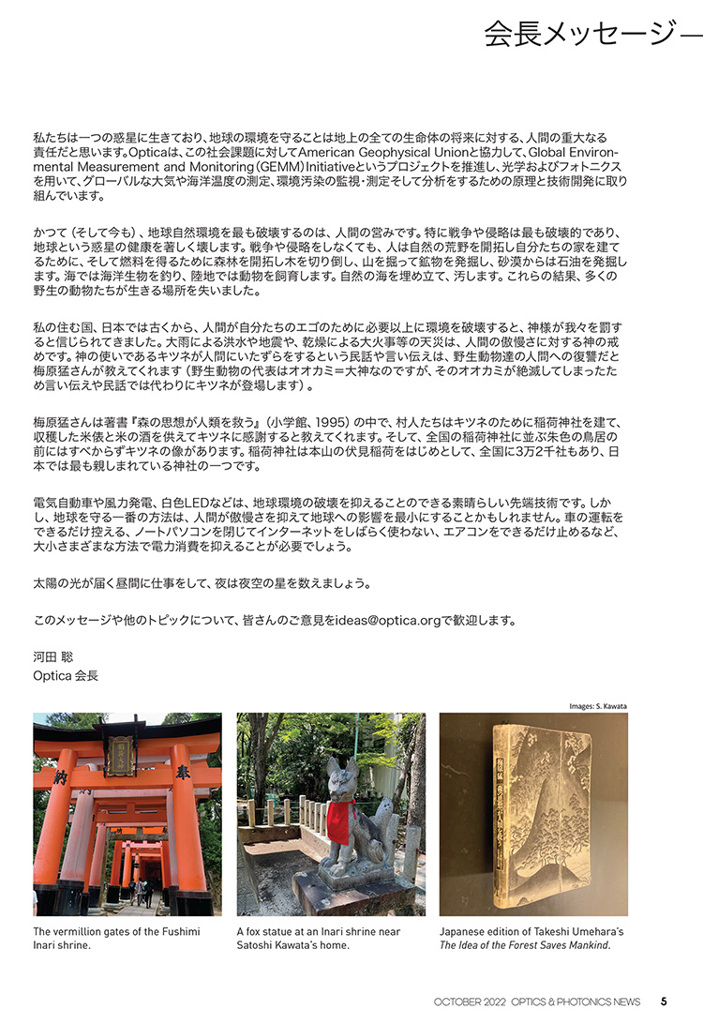 Satoshi Kawata at the Fushimi Inari shrine in Kyoto, Japan.
Satoshi Kawata at the Fushimi Inari shrine in Kyoto, Japan.
We live on one planet, and protecting its environment is our most important responsibility for the future. Part of that responsibility is to develop and apply the principles of optical and photonic technology to monitor, measure and analyze global atmospheric and oceanic temperature, pollution and more. The Global Environmental Measurement and Monitoring (GEMM) Initiative, a joint project of Optica and the American Geophysical Union, is one such effort.
Human activity has been, and remains, the most destructive force for Earth’s natural environment. Warfare and invasions, the worst of human pursuits, of course are also among the worst destroyers of the planet’s health. But people also clear wilderness to grow crops for humans to eat; cut down trees in forests to build houses and burn as fuel; excavate mountains to unearth minerals; drill pristine deserts for oil. We fish, reclaim and pollute the oceans and raise farm animals on land. Many wild animals and plants have lost their habitats as a result.
In Japan, people have long believed that humans who selfishly destroy the environment face punishment from the gods. Natural disasters—floods caused by heavy rains, earthquakes, fires caused by dry weather—were thought to be a warning by the gods against human arrogance. Further, folktales describe how foxes, as messengers of the gods, play tricks on people as the revenge of animals on humans for their encroachment, by plowing, watering and cultivating rice fields, on places where wild animals used to live. (Foxes were probably used as a substitute for wolves, which had been completely extinct in Japan.)
Villagers therefore believe it is at the expense of foxes, as victims of human encroachment, that they are able to grow and eat rice. The Japanese philosopher Takeshi Umehara, in his book The Idea of the Forest Saves Mankind (Shogakukan, 1995), recounts how villagers build shrines called Inari—the literal translation is “harvest of rice,” but it can also mean “fox”—to make amends to foxes, and offer rice bales and sake made from rice in the festival of thanksgiving. Stone statues of a pair of foxes adorn the vermillion gates, or torii, in front of the shrine. Such Inari shrines can be seen everywhere in Japan—there are some 32,000 of them in the country, the most famous of which is the Fushimi Inari in southern Kyoto.
Electric vehicles, wind power and white LEDs are all wonderful technologies that can have a real impact on Earth’s environment. But perhaps the best way to protect the Earth is for humans to curb their arrogance and reduce their harmful impacts. We should cut our power consumption in gestures large and small: driving as little as possible; closing down our laptops and getting off the internet for a while; turning off our air conditioners whenever possible. We should work during the day when the sun’s rays reach us, and count the stars in the sky at night.
Otherwise, someday, the foxes will get even.
I would welcome your thoughts on this message or other topics at ideas@optica.org.
—Satoshi Kawata,
Optica President
A Japanese translation of this message appears below.

